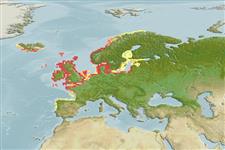Environment: milieu / climate zone / depth range / distribution range
экология
морской; солоноватоводный демерсальный; мигрирует в океане (Ref. 51243); пределы глубины 6 - 30 m (Ref. 57178). Temperate; 80°N - 37°N, 25°W - 36°E
Northeast Atlantic: Murman and Spitzbergen to Portugal, including Iceland and much of the Baltic.
Length at first maturity / Size / Вес / Возраст
Maturity: Lm 13.0, range 11 - 15 cm
Max length : 40.0 cm SL самец/пол неопределен; (Ref. 4674); common length : 20.0 cm TL самец/пол неопределен; (Ref. 4645)
Краткое описание
морфология | морфометрия
Tip of pectoral fin reaches the front end of the dorsal fin. Dark spot on each side of the snout. Two pointed teeth in the palate. Upper jaw not protractile (Ref. 35388).
Inshore, including the inter-tidal zone and estuaries, and offshore to about 60 m depth. Commonly associated with Ammodytes species. Feeds initially on zooplankton, later small fish (clupeids and ammodytids) dominate the diet. Summer batch spawner. Used mainly for fishmeal and oil, but also utilized fresh and pan-fried for human consumption (Ref. 9988).
Muus, B.J. and P. Dahlström, 1974. Collins guide to the sea fishes of Britain and North-Western Europe. Collins, London, UK. 244 p. (Ref. 173)
Статус Красного Списка МСОП (Ref. 130435)
Угроза для людей
Harmless
Использование человеком
рыболовство: важный объект промысла; наживка: occasionally
дополнительная информация
ссылкиаквакультура (рыбоводство)особенности рыбоводствастепень растяжениягенетикаElectrophoresesнаследуемостьболезниобработкаNutrientsMass conversion
инструменты
Специальные отчеты
Скачать в формате XML
ресурсы в Интернет
Estimates based on models
Preferred temperature (Ref.
123201): 8.8 - 12.8, mean 10.3 °C (based on 476 cells).
Phylogenetic diversity index (Ref.
82804): PD
50 = 0.7500 [Uniqueness, from 0.5 = low to 2.0 = high].
Bayesian length-weight: a=0.00269 (0.00152 - 0.00475), b=3.01 (2.85 - 3.17), in cm total length, based on LWR estimates for this species & (Sub)family-body (Ref.
93245).
Trophic level (Ref.
69278): 4.0 ±0.1 se; based on diet studies.
Generation time: 2.7 ( na - na) years. Estimated as median ln(3)/K based on 1
growth studies.
устойчивость к внешним воздействиям (Ref.
120179): средний (среднего размера), минимальное время удвоения популяции 1.4-4.4 года (tm=2; Fec=35,000).
Fishing Vulnerability (Ref.
59153): Low to moderate vulnerability (32 of 100).
Nutrients (Ref.
124155): Calcium = 50.7 [28.6, 103.2] mg/100g; Iron = 0.402 [0.237, 0.669] mg/100g; Protein = 18.9 [17.2, 20.8] %; Omega3 = 0.405 [0.217, 0.718] g/100g; Selenium = 10.1 [4.9, 20.7] μg/100g; VitaminA = 20.1 [7.0, 60.0] μg/100g; Zinc = 0.594 [0.420, 0.824] mg/100g (wet weight);
